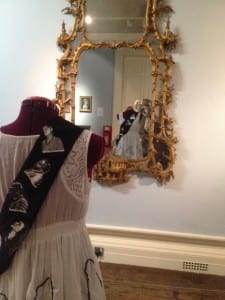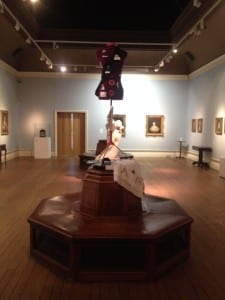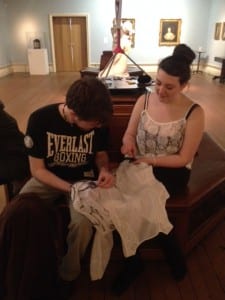Site specific performance can be defined in a number of different ways and many different categories of performance can be placed under the umbrella term, including ‘site-determined’, site-referencing’ and ‘site-responsive'(Pearson, 2010, p.8). Our site was The Collection and The Usher Gallery, a feature of Lincolnshire’s cultural heritage. The Usher Gallery was originally a house built by local jeweller James Usher, who, on the occasion of his death, left his jewellery and art collection to the people of Lincoln. His bequest gifted the beautiful artefacts that are housed there to this day. Our piece of site specific performance ultimately became a site-responsive work, this is because we directly responded the Usher Gallery and the way it, along with countless other Galleries, are curated. However, this performance is the result of a process that began months ago, so let’s begin at the beginning.
To Start
So to start my journey into Site Specific I thought I’d explore the name of our site, The Collection. The idea of collecting something suggests a fondness or an interest in a particular category of item. My interest and, indeed, fondness is soft toys, fig. 1.
In our first mini-session Ally asked us to think about what we collect and the reasons people create collections. Personally, I don’t know when I started collecting, but these are just a few from my collection of over 300 stored at my parents’ house. My reason for collecting is almost an obsession. It’s a longing to gain more and more toys and in my case, to make them feel they belong in my collection by giving the names and histories. I am a caring person and if I lose a teddy or leave them at home whilst I am at university I experience a sort of grief or guilt that I have abandoned them. I feel I have a responsibility for them as they are mine to curate. Hopefully I will be able to weave this obsessive and parental feeling into our work at The Collection.
James Usher’s collection is less sentimental than my own but still it remains that he was a great lover of his collection as it is all perfectly preserved. In his legacy the curators at the Usher continue to display historical, and more importantly, local work. To get us to think about the city in a different way, Ally set us a series of tasks, one of which was to take pictures of ten buildings that fill you with an inconsolable sadness. It seemed, on the surface, to be a simple task that merely required ten photographs, but how to define what the inconsolable sadness would be presented a curious challenge.
The majority of my images were captured on my walk to the Usher, a journey that ordinarily I would tune out with headphones in and tunnel vision. However, given this task made me stop and take notice of the buildings that are a crucial part of how the city of Lincoln has evolved. My first image is that of a pub that has recently been renovated. Not a very sad image, but let me explain. I grew up in the pub industry; my parents have run either pubs or social clubs throughout my life. It has been ingrained into my subconscious what a ‘proper’ pub should be. Old buildings, traditional wood feature such as pews and panelling, hops draped around the walls and most importantly real ale. A ‘proper’ pub should be ale and beer focussed, not attempting to be an alcoholic coffee shop like this newly renovated pub is attempting to be. The sadness I feel is a loss, it’s the taking away of tradition, breaking down the expected and the accepted into something that offers free wifi and celebrates the sale of coffee.
Much like a museum, the public have an expectation of what should be in a pub and what shouldn’t, and although those boundaries for both institutions are now blurring, it is the traditions that are upheld that define them as they are now, not the new emerging conceptions. Museums similarly are accompanied by an expectation, a contract if you will, on the visitors behalf, for quiet, peaceful reflection on the works of art and architecture that are encased within the confines of the museum. A pub on the other hand writes the contract that there will be good beer, clean glasses, snacks available and a lively atmosphere. Both institutions also set out their expectations that the public should respect the doctrine of the place and adjust their behaviour accordingly.
‘The audience is therefore active in the theatrical contract – but what kind of a deal does it set up?’ (Arnold, 1991)
Nicholas Arnold said this regarding the purchase of a ticket for a show, but what he says could also apply to admission for a gallery or even a pint of Bateman’s XB at a pub. A pub has an audience as much as a gallery or a performance, the staff in a pub will have the same contractual obligations as an actor, to entertain and to fulfil the expectations of the patrons. ‘Buying a ticket or entry is willingly giving up a portion of your liquid assets and making a self-limiting commitment to a certain place and time… it is the audiences decision to accept these limitations on freedom. It is an active process of self denial, in return for which a performance is supplied’ (1991). Museums link with this in the way that in return for paying the entrance fee, or for taking the time out to visit specifically, you are expected to be quiet and respectful of other members of the ‘audience’. There is a denial process put into place once you enter the doors that requires discipline, this affected how we thought about putting our piece together as we didn’t want to disrupt the day to day experience of the museum unless it was necessary to the piece. When investigating what would be acceptable at the Usher Gallery, a conversation with a member of the gallery staff revealed that the boundary that they strive to maintain is fairly open: volume is not an issue to be controlled unless it becomes anti-social. In other words, when in the Usher someone could be as loud as they liked so long as no one else minded. So the limitations that are imposed on an audience once they’ve bought a ticket are a lot harsher than those on a gallery visitor once admission has been paid. So are site-specific performances a more ‘user-friendly’ form of theatre, can you even call the pieces created theatre, when the whole reason for their creation is that there aren’t performed in one? This will be an interesting concept to play with when it comes to challenging the limits of behaviour, especially in a space where traditional rules are definitive of the visitors’ experience.
Society of the Spectacle
In 1967 Guy Debord wrote a harsh criticism of societal practices in France, named ‘The Society of The Spectacle’. It was revolutionary and has since sparked a dedicated following of critics and theorists. In his critique he launched an attack on the commodity and fetishist driven culture in 20th century France. Through the medium of film, Debord published his theory visually, to reinforce his commentary he published alongside the film, a written text that was littered with quotes from Marx, Machiavelli and Clausewitz. Throughout the collage style film, the quotes that appear in subtitles and in the commentary are deliberately wrong. Debord intended the audience to be active and to raise a question in regards to whether what they are being told was the truth. In 1960s France this raised queries regarding the recent explosion of advertising in the public sphere, but in regards to our site, these questions could be applied to the truths being claimed around the Usher and Collection. Debord’s theory is based on the opinion that ‘everything that was directly lived has moved away into a representation.’ (Debord, 1967). In other words Debord is suggestion that life is no longer experienced ‘live’ but through a series of images and representation, in arenas such as galleries and theatres. The Usher Gallery was officially opened on the 25th May 1927 by HRH The Prince of Wales and has since been a permanent feature of education and public display. In a gallery or museum it is a fact, taken for granted, that the coordinators and curators of the displays will have thoroughly researched their piece, have the correct history. So what would happen if this information turned out to be incorrect? The assumption we all make when we walk into a museum could prove a fatalistic fact that, by the way it displays the information, an institution could contort the thinking of the patrons, and we could all be putting ourselves at risk of manipulation by going in with passive thinking.
In relation to our specific performance, we are acting on behalf of the female artists. Our caveat to this claim of shared heritage, as women, is to not misrepresent the male artists also featured in the gallery. Just because there is the majority of male artists presented to the visitors does not mean the gallery organization is itself gender biased. We must look beyond that and to the time frames each of the art works. Up until the late 20th century men were perceived as the breadwinners and the dominant figure in the household. So the professions of the era, including artists, will reflect this in its proportional representation. To be fair and honest in our representation of women, we must be fair and make statements that do not defame or belittle the work of the men who have created the work featured.
So, which approach do we take, claiming that women are under-represented and therefore in need of artists that may be of a lesser calibre than the male artists they will replace being shown. Or do we take the stance of a commentary, purely being there to draw attention to the imbalance? This is the next step we must to defining our final performance. Therefore we must reflect this honestly and without bias. In representing the gallery in interaction with the public we must not create a negative image of the museums curation, rather to engage with Debord’s idea that they are merely replaying what has happened in previous galleries before. So Debord suggests to us that we need to question what is presented to us. In The Usher for example we may be presented with majority male artists however, as of the 2011 census women are 51% of the population of Britain, so when within the gallery we hope to support Debord in the process of looking beyond what is presented to us. The claims of the museum may only show us a fraction of the true story. This is where we shall start with devising our work, exposing the faults within the curating process and representing the female artists that the gallery have shown in the last three months. We shall do this in order to highlight the small amount of artists that are represented that are female and to hopefully raise questions on why there aren’t more in the gallery.
Outline of our performance
For our performance the group ‘Stitchouette’ will, through the labour of embroidery attempt to embody the difficulty women artists face to gain the same respect and recognition as their male counterparts. It will be a durational piece that lasts as long as it takes us to painstakingly stich around a template of the artists image. Each Stitchouette on our piece is an artist whose work has displayed in The Usher, in the last three months. Their silhouettes will be documented and recorded by us on a dress, we will do this in recognition of those many other female artists unrepresented by the curators.
Throughout the performance we will be thinking about each of the artists, we have researched and recorded the art works that the artists have on display the usher, a fact about their lives and any significant influences on their work. One of my favourite pieces by our featured artists is Amanda Francis’ Blob. To the normal passer by this would appear as a simple bouncy, malleable ball that resembles a stress ball. In a unique social conceptual performance, Francis set up a market stall in Deptford. The results are shown in the video below.
http://www.youtube.com/watch?v=vQqlA82dzAo
Amanda Francis raises the question of representation. What we would all see as a ball, a stress relieving implement, is then raised as an abstract concept, a representation of what we should be as humans. She suggests that we cannot be brittle and easily breakable or we will not survive. This could apply to the way that site specific theatre has developed over the years and how each performance has moulded itself to the site chosen. This leads to our response to the gallery. As well as responding to the gallery as a collection and the imbalance of male/female we will also be responding to artworks individually centred in the gallery we have chosen as our room and throughout The Usher.
One of these artworks is a pair of vases by Grayson Perry. When seeing this artwork for the first time we were presented with a problem, Perry is an open transvestite. He is born male and identifies himself as such, yet he enjoys becoming his alter ego Claire. In an interview for the Ideas Factory he said this of his alter-ego in regards to his pottery.
‘Do you actually produce work as Claire or Grayson? How does that work?
GP: How does Claire work? It’s funny. I’ve just been doing this thing for CNN, and the woman really wanted to film Claire doing something she does naturally. I said: “Claire does not do anything naturally. Claire is not a real person; it’s me in a frock.” All I do is swan about, look at myself in the mirror and primp, and go to parties, smile and have a nice time. She does not DO anything – she doesn’t even make a bit of toast.’ (Interview with Grayson Perry)
He is comfortable as a woman, this is where we were presented with a problem. Do we recognise him in our work, or will he count as a man. It is clear in this interview that he does not create as Claire, however, Harriet and I discussed and decided to include him. We reached this decision based on the fact that due to his transvestism we felt he sympathised with women, and indulged in his alter ego for his own pleasure, not due to any political or radical impulse to rebel against the ideology of his field.
Reflections on Technical Rehearsal
Thursday presented the opportunity for a last on-site rehearsal with all props and accoutrement. However, upon arrival at the Usher the gallery exhibit that our piece responded to had been changed. The room that is our setting was a series of female artists and female inspired art, we were then faced with the new exhibit that featured a prominent Lincolnshire family. However inspiring this new collection is, it presented a problem, we now had to make our performance relevant to the new room. Luckily for our piece, we are able now to literally ‘reflect’ on the women artists. Now contained in our chosen room is a Pier Mirror, accredited to Thomas Johnson, it has a rococo frame and different plates of glass that most recently would be 19th century replacements.
Shown here in the image the mirror allowed us the opportunity to physically reflect on the artists we would then continue to stitch. This is where we introduced a reflective monologue for each artist detailing their date of birth, location, genre of art and piece shown in The Usher. Through this verbal recognition in front of the mirror we hope to attract the attention of the Usher’s patrons and invite them to reflect with us.
Day of The Performance
Our performance times on Saturday 10th May were 11-1 and then 2-4. We hoped to complete the garment by the afternoon session in order to display it as an installation for a few hours. Once we had our mannequin all set up we began with a run through of all the artists’ information monologues and then we settled into the flow of our durational piece. Unfortunately the morning session was very quiet, there were few visitors and those who were about were not engaging as much as we had hoped. However discouraging this was we persevered and kept sewing as each of the silhouettes represented a woman who had struggled to create a piece of work worthy of their place in The Usher. Coming back for the afternoon session proved very positive as we had many more patrons of the museum engage, including a young man, Kieran Martin* who sat and sewed with us, discussing the artists we have included, we then thanked him and off he went to the gallery. Upon discussion with him later we discovered that he had then toured the gallery a second time and actively sought out the pieces created by women. Noticeably he said ‘I couldn’t believe how much of this gallery is all male, I mean the women just are scattered, not featured in any way'(Martin*, 2014).
Overall I believe our performance had the impact we had intended, it made people think about our topic in a new way, and even made them look twice at the gallery around them. I we were to do anything differently I would have had a third performer in our group to wear the dress as we sewed to create a bigger talking point. Also I would have made a bigger feature of the monologues about the artists, it was a talking point that became one of the main features of the piece and had we had longer between the technical and the performance it would have developed into a more rehearsed and cohesive verbal feature. However due to time limits I am happy with our performance and the impression we created, we completed the dress and even converted a few people to become Stithouettes.
Works Cited
Pearson, M (2010) Site Specific Performance, Baskingstoke, Palgrave Macmillan
Grayson, S (2014) Fig.1 Cuddly Collection. (February 2014)
Grayson,S (2014) Fig. 4 Stitchouette Set Up (May 2014)
Grayson, S (2014) Fig.5 Male Stitchouette (May 2014)
Grayson, S. (2014) Fig.2 West End Tap (February 2014)
Grayson,S (2014) Fig. 3 Pier Mirror (May 2014)
Martin, Kieran* (2014) Interview with male participant. [Interview] Interviewed by Sophie Grayson, 10th May 2014. *Did not have permission to use real name, name has been changed.
Top of The Pots: Interview with Grayson Perry. (2005) Available from http://www.saatchigallery.com/artists/grayson_perry_articles.htm. Accessed 6th May 2014
Arnold, Nicolas. (1991)The Manipulation of The Audience by Director and Actor. In: ed G.D Wilson, Psychology and Performing Arts. London. Swets & Zeitlinger. Chapter 6 pp 75-82





